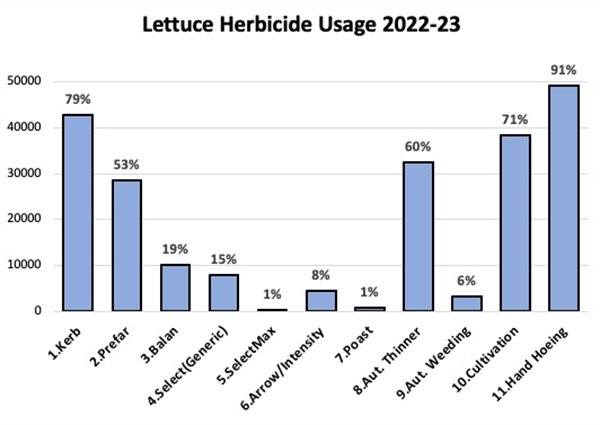
As part of the Southwest Ag Summit (SWAS) that took place in Yuma in late February, we conducted a breakout session on Thursday, 22 February 2024 titled “Colorado River Water Shortage: Agricultural Perspectives”.
This session provided a brief review of the background, the current situation on the Colorado River, and very importantly it included an outlook on the current discussions among the basin states to negotiate a new compromise for the guidelines of use under conditions of water shortage. These new guidelines will go into place at the end of 2026. Both the upper and lower basin states have now submitted draft proposals to the Bureau of Reclamation (BoR) on 6 March 2024.
This breakout session at the Southwest Ag Summit provided up to date information and first-hand insight into the process. The participants were each uniquely qualified to offer valuable perspectives on these issues.
The participants included Elston Grubaugh, Wellton-Mohawk Irrigation and Drainage District, who introduced the discussion and served as program moderator. Bart Fisher, Palo Verder Irrigation District and State of California Colorado River Water Board member, Fisher Ranch, Blythe CA, provided a California perspective with a background of extensive experience in Colorado River management over several decades. Hank Auza, Yuma County Water User’s Association President and Yuma Ag Water Coalition representative, Barkley Co. of Arizona, Yuma AZ, provided an Arizona perspective.
Elston has extensive experience working in irrigation districts on both the California and Arizona sides of the Colorado River. He has a valuable perspective, and he plays an important role in the management of Colorado River water in the Yuma area. We are fortunate to have Elston provide his direction for this program and offer his point of view.
Both Bart and Hank are directly involved in the ongoing reconsultation negotiations directed at developing the new Colorado River management guidelines that will go into place in 2026. Both are part of their state's delegation in the current negotiations and represent the lower basin. Bart and Hank are not only responsible for representing California and Arizona, but they are both active farmers in the Palo Verde Valley and Yuma area valleys, and they bring valuable perspectives to the discussions.
The goal of negotiations among the seven U.S. Colorado River basin states has been to submit a single document proposing guidelines to the BoR. However, as was discussed at this program at the SWAS, the upper and lower basin state groups have been dealing with significant differences and were not able to come to a consensus agreement. As a result, the upper and lower basin delegations each submitted separate proposals to the BoR in early March.
There is still a chance that both the upper and lower basin state groups can reach a common agreement for a unified proposal. In the meantime, both proposals are under review by the BoR. Officials with the BoR have indicated that they will be working with the basin states in the next six months to develop a consensus draft proposal for post-2026 river management by the end of 2024.
Further details on the two proposals submitted on 6 March 2024 by the upper and lower basin groups and contrasting the two will be forthcoming in a future article.
For the excellent program that was provided at the 2024 SWAS, I want to thank Elston, Bart, and Hank for their outstanding presentations. Each of the participants in this program brought a wealth of knowledge and experience to the discussion.
Specifically for Bart and Hank, we are all indebted to them for their contributions and hard work while serving on the lower basin state delegations during these critical and challenging negotiations. Their firsthand perspectives and contributions to this program are very much appreciated.
Frost and freeze damage affect countless fruit and vegetable growers leading to yield losses and occasionally the loss of the entire crop. Frost damage occurs when the temperature briefly dips below freezing (32°F).With a frost, the water within plant tissue may or may not actually freeze, depending on other conditions. A frost becomes a freeze event when ice forms within and between the cell walls of plant tissue. When this occurs, water expands and can burst cell walls. Symptoms of frost damage on vegetables include brown or blackening of plant tissues, dropping of leaves and flowers, translucent limp leaves, and cracking of the fruit. Symptoms are usually vegetable specific and vary depending on the hardiness of the crop and lowest temperature reached. A lot of times frost injury is followed by secondary infection by bacteria or opportunist fungi confusing with plant disease.
Most susceptible to frost and freezing injury: Asparagus, snap beans, Cucumbers, eggplant, lemons, lettuce, limes, okra, peppers, sweet potato
Moderately susceptible to frost and freezing injury: Broccoli, Carrots, Cauliflower, Celery, Grapefruit, Grapes, Oranges, Parsley, Radish, Spinach, Squash
Least susceptible to frost and freezing injury: Brussels sprouts, Cabbage, Dates, Kale, Kohlrabi, Parsnips, Turnips, Beets
More information:
Time flies. February is right around the corner and that means it is farm equipment/ag trade show season. Upcoming regional events include the World Ag Expo, Tulare, CA, February 13-15, the Southwest Ag Summit, Yuma, AZ, February 20-22, and AgroBaja, Mexicali, Mexico, March 7-10. If you are interested in the latest ag tech and farm machinery, all are outstanding events and well worth attending. For more information, click on the links below.

Fig. 1. Upcoming farm equipment/ag trade show events: World Ag Expo, Tulare,
CA, February 13-15, 2024 theSouthwest Ag Summit, Yuma, AZ, February 20-
22,2024 and AgroBaja, Mexicali, Mexico, March 7-10, 2024.
Last May we conducted our “Lettuce Insect and Weed Losses Survey”. Thank you for participating and providing real world data that shows us what are the trends in herbicide usage. Arizona does not require complete reporting for private applicators, so we appreciate you providing this difficult to acquire information. In addition to herbicide use we included in the most recent survey questions related to other methods of weed control such as automated thinning, automated weeding, cultivation hand weed control. The results reflect data obtained from PCAs in more than 54,000 acres of lettuce scouted and we believe they accurately represent what goes on in the field. Results of the weed section for the 2022-2023 season appear in the chart below. Some highlights of last season (Figure 1) are that 79% of the acres were treated with Pronamide (Kerb), 53% with Bensulide (Prefar) and 19% with Benefin (Balan). This is consistent with a previous survey conducted in 2018-2019. Regarding grass herbicides, last season shows that 24% of the acres surveyed received an application of Clethodim products and 1% of Sethoxidim. With respect to automated thinning, it is interesting that it was used in 60% of the acres representing an increase from 2018-19, which was reported on 40% of the reported acres (Tickes 2019)1.
Additionally, we can see that automated weeding was used in 6% of the acres, which could increase in the future as the industry prepares for possible scarce labor resources. The hand weeding and cultivation continues to be a control strategy that is used in most of the acres in our area with 91 and 71% respectively.

Results of pheromone and sticky trap catches can be viewed here.
Corn earworm: CEW moth counts remain at low levels in all areas, well below average for this time of year.
Beet armyworm: Trap increased areawide; above average compared to previous years.
Cabbage looper: Cabbage looper counts decreased in all areas; below average for this time of season.
Diamondback moth: DBM moth counts decreased in most areas. About average for this time of the year.
Whitefly: Adult movement beginning at low levels, average for early spring.
Thrips: Thrips adult counts reached their peak for the season. Above average compared with previous years.
Aphids: Aphid movement decreased in all areas; below average for late-March.
Leafminers: Adults remain low in most locations, below average for March.